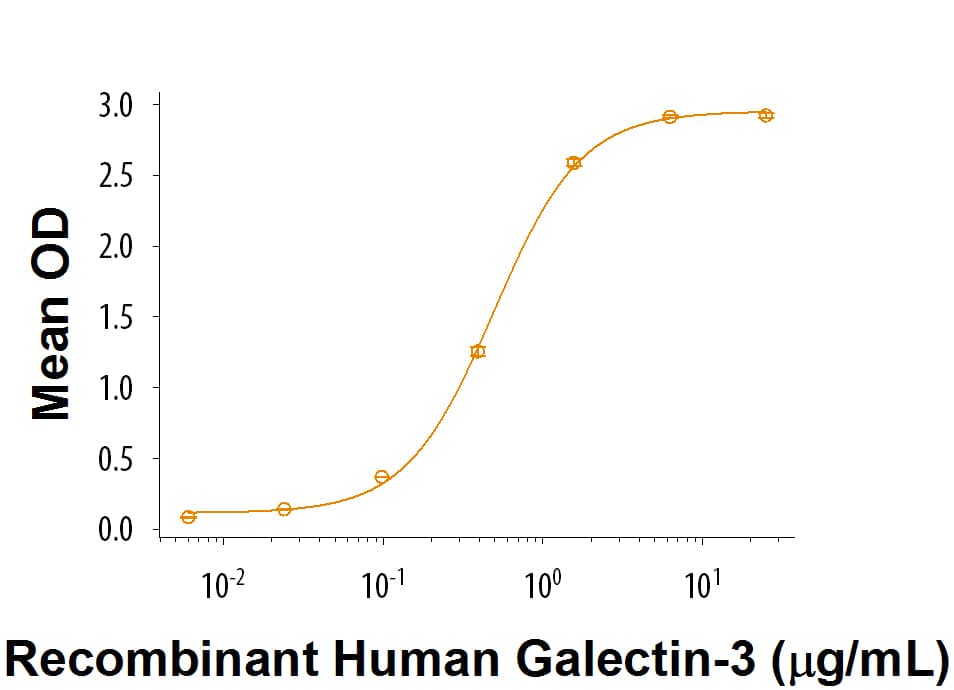Recombinant Human MCAM/CD146 Fc Chimera Protein, CF
R&D Systems, part of Bio-Techne | Catalog # 9709-MA

Key Product Details
Source
NS0
Accession #
Structure / Form
Disulfide-linked homodimer
Conjugate
Unconjugated
Applications
Bioactivity
Product Specifications
Source
Mouse myeloma cell line, NS0-derived human MCAM/CD146 protein
| Human MCAM/CD146 (Val24-Gly559) Accession # AAA20922 |
IEGRMD | Human IgG1 (Pro100-Lys330) |
| N-terminus | C-terminus |
Purity
>95%, by SDS-PAGE visualized with Silver Staining and quantitative densitometry by Coomassie® Blue Staining.
Endotoxin Level
<0.10 EU per 1 μg of the protein by the LAL method.
N-terminal Sequence Analysis
Val24
Predicted Molecular Mass
87 kDa
SDS-PAGE
108-124 kDa, reducing condtions
Activity
Measured by its binding ability in a functional ELISA.
When Recombinant Human MCAM/CD146 Fc Chimera is immobilized at 1 μg/mL, 100 μL/well, it binds Recombinant Human Galectin-3 (Catalog # 8259-GA). The concentration of Recombinant Human Galectin-3 that produces 50% of the optimal binding response is 0.25-1.25 μg/mL.
When Recombinant Human MCAM/CD146 Fc Chimera is immobilized at 1 μg/mL, 100 μL/well, it binds Recombinant Human Galectin-3 (Catalog # 8259-GA). The concentration of Recombinant Human Galectin-3 that produces 50% of the optimal binding response is 0.25-1.25 μg/mL.
Scientific Data Images for Recombinant Human MCAM/CD146 Fc Chimera Protein, CF
Recombinant Human MCAM/CD146 Fc Chimera Protein Bioactivity
When Recombinant Human MCAM/CD146 Fc Chimera is immobilized at 1 µg/mL, 100 µL/well, Recombinant Human Galectin-3 (Catalog # 8259-GA) binds with an ED50 of 0.25-1.25 ug/mL.Formulation, Preparation and Storage
9709-MA
| Formulation | Lyophilized from a 0.2 μm filtered solution in PBS. |
| Reconstitution |
Reconstitute at 500 μg/mL in PBS.
|
| Shipping | The product is shipped at ambient temperature. Upon receipt, store it immediately at the temperature recommended below. |
| Stability & Storage | Use a manual defrost freezer and avoid repeated freeze-thaw cycles.
|
Background: MCAM/CD146
References
- Lehmann, J.M. et al. (1989) Proc Natl Acad Sci U.S.A. 86:9891.
- Alais, S. et al. (2001) J. Cell Sci. 114:1847.
- Shih, I.M. et al. (1994) Am J Pathol. 145:837.
- Schrage, A. et al. (2008) Histochem Cell Biol. 129:441.
- Wang Z and Yan X. (2013) Cancer Lett. 330:150.
- Bardin, N. et al. (2006) Inflamm Bowel Dis. 12:16.
- Xing, S. et al. (2014) Am J Pathol. 184:1604.
- Ma, X. et al. (2017) Oncol Lett. 13:1681.
- Colomb F, et al. (2017) J Biol Chem. 292:8381.
Long Name
Melanoma Cell Adhesion Molecule
Alternate Names
CD146, L-Gicerin, MUC18
Gene Symbol
MCAM
UniProt
Additional MCAM/CD146 Products
Product Documents for Recombinant Human MCAM/CD146 Fc Chimera Protein, CF
Product Specific Notices for Recombinant Human MCAM/CD146 Fc Chimera Protein, CF
For research use only
